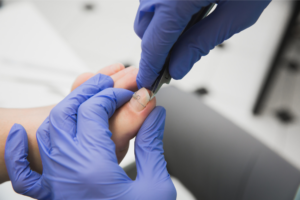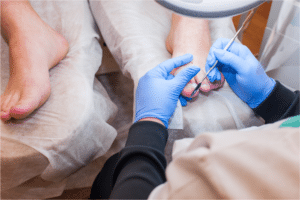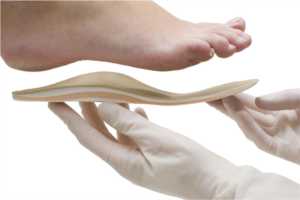PODIATRY
Podiatry is a branch of medicine that specializes in the foot, ankle, and lower leg. Doctors in this field diagnose, prevent, and treat many common issues like bunions and ingrown toenails to more complex problems like diabetic foot ulcers and sports injuries.
Don’t let foot pain slow you down! Our podiatrists are highly qualified foot and ankle specialists with a Doctor of Podiatric Medicine (DPM) degree. Their education is similar to medical doctors (MDs) and osteopathic doctors (DOs), involving:
- 4 years of undergraduate studies
- 4 years at an accredited podiatric medical school
- 3-4 year hospital residency focusing on surgery
Our podiatrists go beyond treating existing issues like bunions or heel pain. They address the underlying cause of your discomfort and prevent future problems. They can also help those at risk for foot complications, such as diabetics.
Whether you’re experiencing chronic foot pain, have a nagging foot wart, or simply want to maintain healthy feet, a podiatrist in Los Angeles is the foot health specialist to see.
Schedule an appointment at LA Foot Laser today and take a step towards pain-free feet!
WOUND CARE
Foot and ankle wounds can be a significant health concern, especially for those with diabetes or circulatory issues. Podiatrists in Los Angeles, with their specialized training in the lower leg, play a vital role in wound care
Below are the following most common causes of foot wounds treated at our practice:
- Trauma and injuries
- Neuropathy
- Burns
- Bony infection
- Diabetic foot ulcers
- Healing impairments
- Surgical complications
- Venous stasis ulcers
- Vascular insufficiency
- Pressure and strains
These wounds, particularly diabetic foot ulcers and those caused by poor circulation, pose a significant risk of infection, especially for those with underlying health conditions.
Our comprehensive approach to wound care starts with identifying the root cause of the wound, such as diabetes, malnutrition, or poor blood flow. Then, we customize patient treatment plans to alleviate symptoms, prevent infection, and promote optimal healing.
Below are the most common factors that compromise wound recovery:
- Elevated glucose levels or poorly managed diabetes
- Poor nutrition
- Smoking
- Peripheral vascular disease
- Obesity
- Low tissue oxygenation
Infection is a serious risk, especially for individuals with underlying health conditions. We encourage those experiencing foot issues to seek medical attention and wound care early on.
Our expert podiatrists in Los Angeles diagnose and treat all types of foot wounds. Our treatments consist of medicines and biologics that optimize healing and the removal of unhealthy or damaged tissues and foreign materials from wounds.
At-risk individuals must monitor their foot health to prevent serious complications, such as ulcers and infections. To promote foot health, we offer the following wound care strategies.
- Dead/damaged tissue removal
- Specialized wound dressings to protect healing tissues and wounds
- Diabetic foot health management
- Weight management
- Foot health education
- Medications and antibiotics to combat infection and medications to improve circulation
Podiatrists in Los Angeles also work closely with patients to promote healthy lifestyle habits like proper foot care and ensure optimal healing to minimize the risk of complications, including amputation.
INGROWN TOENAILS
 Ingrown toenails occur when the edge of the nail grows into the surrounding skin, leading to pain, redness, and swelling. Common causes include:
Ingrown toenails occur when the edge of the nail grows into the surrounding skin, leading to pain, redness, and swelling. Common causes include:
- improper nail trimming
- tight footwear
- injuries
Treatment options range from soaking the affected foot in warm water to surgical removal of the ingrown portion of the nail. Seeking prompt medical attention can prevent complications such as infection and promote quicker healing.
Ingrown toenails affect individuals of all ages. Below are the most common risk factors that elevate one’s chances of developing them.
- Genetics
- Poorly fitted footwear
- Trauma or injuries to the toes
- Fungus
- Improper nail-trimming habits
There are various podiatry treatments available for ingrown toenails. These methods range from alleviating pain and discomfort to preventing infection and promoting toenail health.
- Self-Care Management typically involves soaking the affected foot in warm, soapy water to soften the nail and reduce inflammation. Gentle massage of the surrounding skin to promote drainage and relieve pressure. Application of over-the-counter antibiotic ointments to prevent infection.
- Partial Nail Avulsion involves trimming or removing the portion of the nail that is ingrown. It is often done under local anesthesia to minimize discomfort. After removing the ingrown portion, the podiatrist may apply a chemical or physical agent to prevent regrowth of the nail border.
- Total Nail Avulsion is reserved for severe cases or when ingrown toenails are recurrent. The entire nail may need to be removed. The procedure is performed under local anesthesia and involves removing the entire nail plate. It allows for the podiatrist to address any underlying nail bed abnormalities.
- Nail Bracing or Splinting is recommended for recurring ingrown toenails. These techniques aim to straighten the nail, encourage it to grow in a healthier direction, and prevent it from growing into the skin.
- Chemical Cautery (Phenolization) can be performed after partial nail avulsion, the podiatrist may use a chemical cauterizing agent like phenol to destroy the nail matrix, preventing the ingrown portion from regrowing. Chemical cautery is effective in preventing the recurrence of ingrown toenails by permanently altering the nail matrix.
- Laser Ingrown Toenail Treatment targets the tissue around the nail matrix to prevent regrowth. Laser treatment is often preferred for its precision and minimal discomfort, and it can be an effective option for recurrent ingrown toenails.
- Antibiotics and prescription medications are provided for cases where infection is present to eradicate it and prevent its spread. These meds are used in conjunction with other treatments to address both the ingrown toenail and any associated infection.
- Custom orthotic devices or inserts may be recommended to alleviate pressure on the affected toe and promote proper foot alignment and nail growth.
Podiatrists often provide education on proper nail-trimming techniques and footwear choices to prevent ingrown toenails from recurring.
By employing these various treatments, podiatrists can effectively manage ingrown toenails, relieve discomfort, and prevent recurrence, ultimately improving the patient’s quality of life and foot health.
TINEA PEDIS (FUNGAL FOOT INFECTION) & Toenail Fungus
Athlete’s foot, also known as tinea pedis, is a common fungal infection that affects the skin on the feet. It can occur concurrently with other fungal infections like tinea cruris, tinea manuum, or tinea unguium and affect multiple toes at the same time. Symptoms typically appear as redness, itching, and scaling between the toes or on the soles of the feet. This condition is caused by fungi that thrive in warm, moist environments, such as sweaty socks and shoes or public shower areas.
Toenails infected with tinea pedis often appear misshapen, thickened, or partially destroyed (dystrophic) and may resemble fungal nail infections (onychomycosis), especially in individuals who engage in sports like running, soccer, basketball, and tennis, which can lead to foot trauma. Diagnosis typically involves various lab tests. Due to the slow growth of toenails, treatment may span 9-12 months.
Tinea pedis can be treated with over-the-counter antifungal medications, such as creams, powders, or sprays. Keeping the feet clean and dry, wearing breathable socks and shoes, and avoiding walking barefoot in public places can help prevent athlete’s foot. In some cases, prescription-strength antifungal medications may be necessary for more severe or persistent infections.
Prompt podiatry care in Los Angeles is available at LA Foot Laser and can help alleviate symptoms and prevent the spread of the infection to other areas of the body.
Tinea Unguium (Toenail Fungus)
 Another fungal infection known as tinea unguium commonly affects toenails, particularly in older adults, men, individuals with diabetes, and those with weakened immune systems due to conditions like peripheral vascular disease. Infection often occurs through direct contact with the fungus, such as sharing towels or walking barefoot in public changing areas.
Another fungal infection known as tinea unguium commonly affects toenails, particularly in older adults, men, individuals with diabetes, and those with weakened immune systems due to conditions like peripheral vascular disease. Infection often occurs through direct contact with the fungus, such as sharing towels or walking barefoot in public changing areas.
Treatment typically involves antifungal medications, creams, sprays, or oral medications, along with proper foot hygiene and keeping the feet clean and dry. Severe cases may require prescription-strength treatments or laser therapy. Prevention measures include wearing breathable footwear, avoiding walking barefoot in public areas, and promptly treating any signs of infection.
Both tinea pedis and tinea unguium are highly contagious and can be transmitted through direct contact or by sharing contaminated items like towels or shoes.
VERRUCAE (PLANTAR WARTS)
Verrucae, commonly known as plantar warts, are small, rough growths that typically appear on the soles of the feet. They are caused by the human papillomavirus (HPV) and are often found in areas subjected to pressure, such as the heels or balls of the feet. Plantar warts can become painful, especially when walking or standing.
These warts can appear as flat or raised lesions with a rough surface and may have tiny black dots, which are actually small blood vessels clotted within the wart. Plantar warts can spread from person to person through direct skin contact or by walking barefoot in public places like locker rooms or swimming pools.
If you suspect you have plantar warts or are experiencing persistent or significant foot pain, seek treatment at LA Foot Laser, a podiatry in Los Angeles for diagnosis and a personalized treatment plan.
BIOMECHANICS
Foot biomechanics refers to the study of the structure and function of the foot; how it moves and supports the body during various activities like walking, running, and jumping. It involves analyzing the complex interaction between bones, muscles, ligaments, and tendons to understand how they work together to provide stability, propulsion, and shock absorption. Feet issues can affect other areas of the body, especially those involved with mobility and walking. In many cases, calluses can highlight the point of origin for foot issues.
Key aspects of foot biomechanics include:
Gait analysis: Studying the pattern of movement of the foot and lower limb during walking or running to identify abnormalities or asymmetries.
Foot posture: Assessing the alignment of the bones and joints in the foot, including arch height and foot position at rest and during weight-bearing activities.
Pronation and supination: Understanding the natural inward (pronation) and outward (supination) rolling motion of the foot and how excessive or inadequate movement can contribute to injury or dysfunction.
Foot pressure distribution: Evaluating how pressure is distributed across the sole of the foot during weight-bearing activities and how it may affect gait and posture.
Podiatrists in Los Angeles are experts in foot biomechanics and diagnose and treat various foot conditions and recommend appropriate footwear and/or orthotics to help individuals optimize their movement patterns to prevent injuries and improve performance.
CUSTOM ORTHOTICS AND BRACING
 Incorrect alignment of the foot during walking, such as overpronation (when the foot rolls inward) or oversupination (when it rolls outward), can impact the knee, hip, and lower back. Overpronation can lead to internal rotation of the leg, increasing stress on the knee’s medial collateral ligaments and causing hip pain. Custom orthotics and bracing are useful in correcting biomechanical imbalances and optimizing the positioning of the muscles, ligaments, tendons, bones, and joints of the foot and lower limbs for better stability.
Incorrect alignment of the foot during walking, such as overpronation (when the foot rolls inward) or oversupination (when it rolls outward), can impact the knee, hip, and lower back. Overpronation can lead to internal rotation of the leg, increasing stress on the knee’s medial collateral ligaments and causing hip pain. Custom orthotics and bracing are useful in correcting biomechanical imbalances and optimizing the positioning of the muscles, ligaments, tendons, bones, and joints of the foot and lower limbs for better stability.
Orthotics are available by prescription and designed from a physical impression of the patient’s foot and their overall health and foot care profile. Individuals with certain concerns should see a podiatrist in Los Angeles for prescription orthotics that enhance their foot health and comfort. Custom orthotics are an invaluable investment that are more durable than over-the-counter orthotic aids.
CONDITIONS PODIATRISTS TREAT
Our podiatrists treat the following foot disorders in Los Angeles:
- Plantar fasciitis
- Heel spurs
- Achilles tendonitis
- Ingrown toenails
- Blisters
- Corns and calluses
- Bunions
- Hammertoes
- Neuromas
- Plantar warts (verrucae)
- Morton’s neuroma
- Flat feet (pes planus)
- High arches (pes cavus)
- Shin splints
- Stress fractures
- Metatarsalgia
- Tarsal tunnel syndrome
- Athlete’s foot (tinea pedis)
- Fungal toenails (onychomycosis)
- Gout
- Diabetic foot complications
- Abnormal Growths
- Arthritis
- Foot Deformities
- Fractures and Sprains
- Heel Pain
- Infection Management and Amputation Prevention
- Pinched nerves
- Plantar Fasciitis
- Plantar Warts
- Sports Injuries
They also treat patients with these symptoms:
- Pain in the arches
- Heel fissures
- Foot lacerations or fissures
- Profuse perspiration
- Painful feet
- Wart-like growths
- Aching heels
- Neuropathy
- Sensory disturbances like numbness and tingling
- Various skin and nail issues
- Flaking or shedding skin on the soles
- Toenails that are thickened or discolored
Our podiatrists in Los Angeles specialize in offering comprehensive foot care for those dealing with foot and ankle issues that may or may not be exacerbated by underlying health concerns. Contact LA Foot Laser today for diagnosis, treatment and to learn preventative strategies to protect your foot health and comfort.

